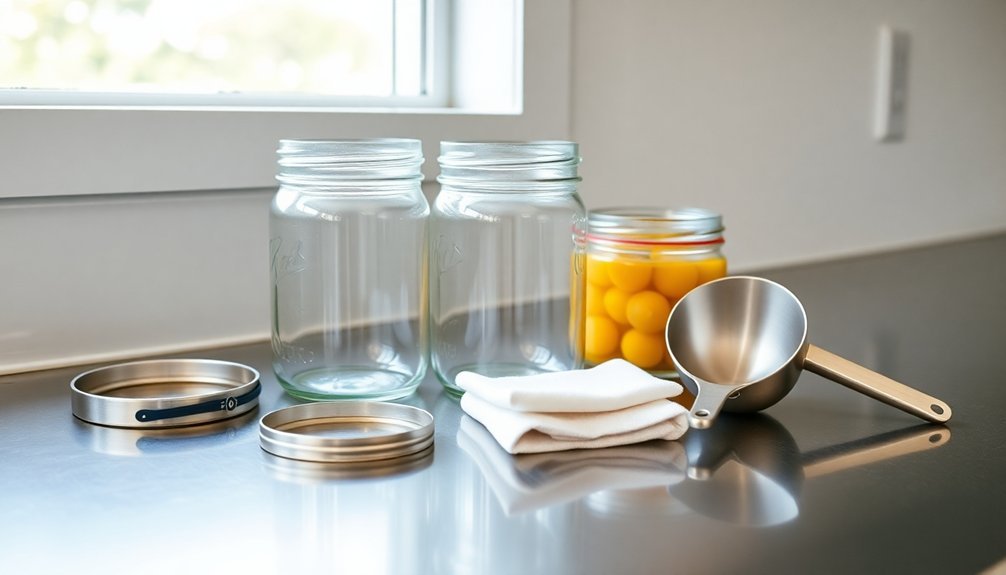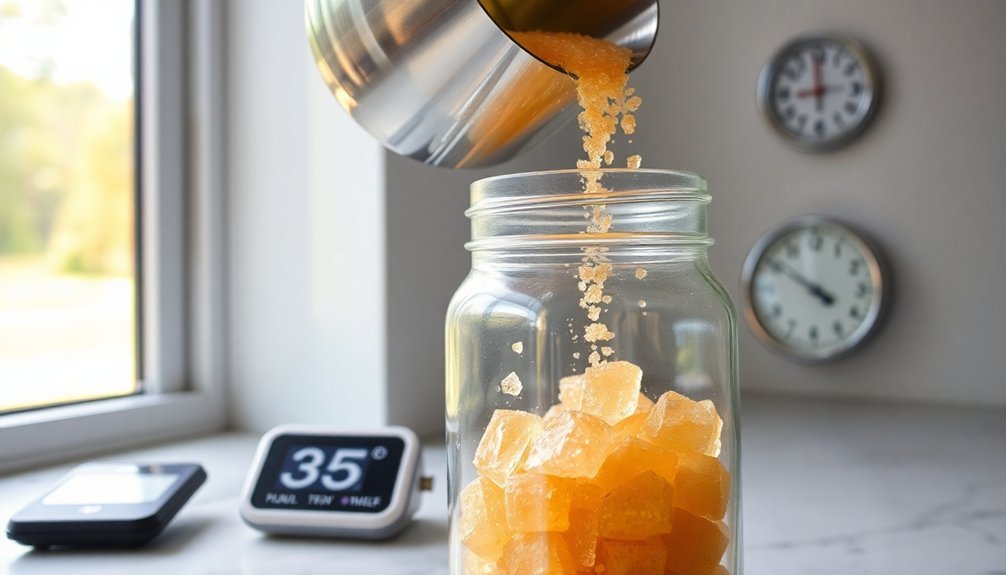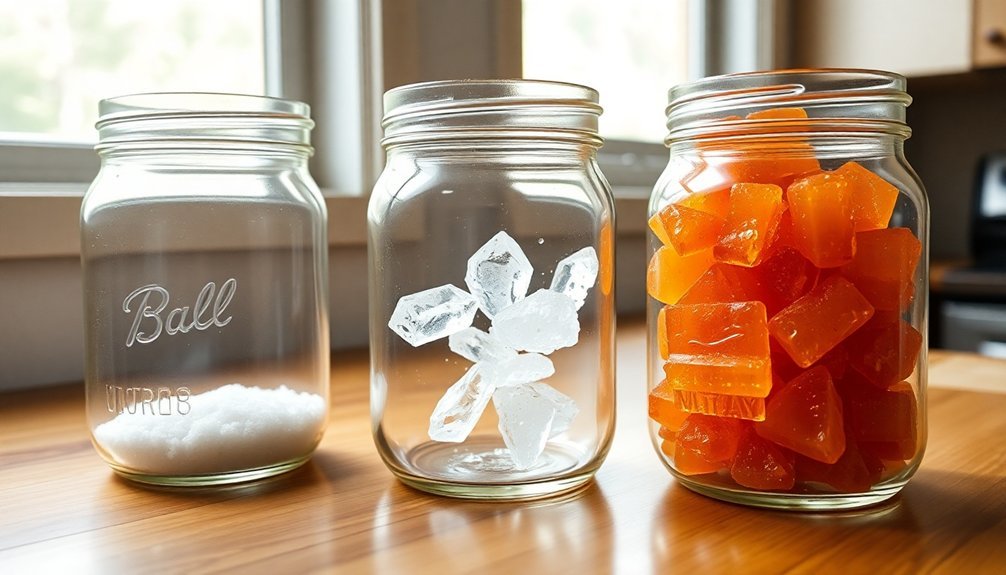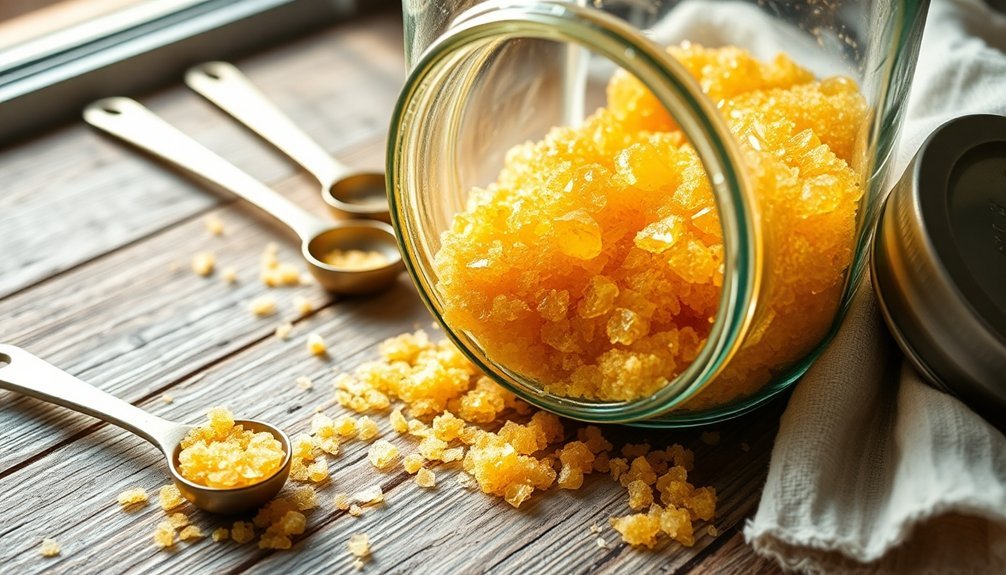You'll need food-grade containers that are clean, dry, and airtight to store traditional sugar crystals properly. Choose either glass jars with silicone gaskets or plastic containers with tight seals, and make sure they're opaque to protect against light exposure. Keep your sugar in a cool, dry place with temperatures between 50-65°F and humidity below 50%. Transfer sugar from its original packaging into your chosen containers, and store them elevated off the floor, away from heat sources and strong odors. While sugar has an indefinite shelf life when stored correctly, there's much more to maintaining its ideal quality for long-term storage.
Preparing Storage Equipment

When storing sugar crystals for long-term preservation, you'll need to start with the right storage equipment and proper preparation. Choose from several reliable container options, including food-grade plastic buckets, glass canning jars, #10 cans, polyethylene bags, or Mylar-type bags. Each container must be thoroughly cleaned and completely dry before use. Shelf stability is indefinite when sugar is properly stored in appropriate containers.
You'll want to verify your chosen containers provide an airtight seal to prevent moisture from entering, though removing oxygen isn't necessary for sugar storage. If you're using metal containers or lids, verify they're lined with food-grade material to prevent rusting. For the best protection, select opaque containers or store clear containers in a dark place.
Don't forget to implement proper handling processes to prevent cross-contamination between different sugar types. If you're using storage silos, install vibrating bottom plates and level probes to maintain smooth product flow.
Keep your storage area clean and dust-free by establishing regular maintenance routines. When setting up your storage space, avoid areas near heating vents, cooling units, or windows that receive direct sunlight, as temperature fluctuations can affect sugar quality.
Selecting Sugar Types
With your storage equipment properly prepared, the next step is choosing the right types of sugar for long-term preservation. Granulated sugar is your best option for extended storage, as it maintains quality indefinitely when properly stored.
You'll want to select pure, refined granulated sugar rather than raw varieties to guarantee the longest possible shelf life. Store sugar in an airtight container to prevent moisture-induced hardening.
While powdered sugar might seem like a good choice, it's not ideal for long-term storage due to its moisture sensitivity and tendency to form irreversible lumps.
Similarly, brown sugar requires specific moisture conditions and is best used within six months, though you can freeze it to extend its shelf life.
If you're considering liquid sweeteners, opt for commercial filtered honey or maple syrup rather than unfiltered or raw varieties.
You'll need to store these in glass canning jars or #10 cans, as honey's acidic nature can react with metal containers.
Don't store unfiltered products, as they're more prone to fermentation and spoilage.
While all sugar types have their uses, granulated sugar remains your most reliable choice for creating a lasting food storage supply.
Measuring Temperature and Humidity

After securing your sugar supply, maintaining proper temperature and humidity levels becomes critical for long-term storage success.
Sugar's hygroscopic properties make it particularly sensitive to moisture in the air. You'll need to keep your storage area between 22-26°C (72-79°F) during handling and 10-18°C (50-65°F) for long-term storage. Ascertain your storage space maintains humidity levels below 50% to prevent sugar from becoming sticky or developing mold.
To monitor these conditions effectively, you'll want to invest in a reliable Bluetooth temperature and humidity data logger, such as the BlueTag TH20.
These devices can track both measurements simultaneously and connect to monitoring apps like T-keeper for real-time alerts. Set up alarms for when conditions fall outside acceptable ranges.
Watch for warning signs of poor temperature and humidity control. If your sugar starts clumping or developing a white film, you're likely experiencing humidity issues.
Temperature fluctuations can cause unwanted crystallization or melting. Regular monitoring helps you catch these issues before they affect your entire sugar supply.
Check your readings at least daily and maintain detailed records of any significant changes in environmental conditions.
Container Selection and Preparation
When storing sugar crystals, you'll want to choose either glass canning jars, food-grade plastic buckets, or polyethylene bags as your primary storage containers, ensuring they're opaque to protect against light exposure.
Before using any container, you must thoroughly clean and dry it, removing all traces of moisture that could cause sugar clumping.
It's crucial to eliminate any residual odors from your chosen containers, as sugar readily absorbs surrounding scents, which can affect its quality.
Best Container Materials
Selecting the right container for sugar storage can make the difference between perfectly preserved crystals and a clumped, unusable mess.
You'll find that glass containers, particularly those made from borosilicate or tempered glass, offer superior protection against moisture and unwanted odors. These containers won't absorb stains or smells, and you can safely clean them in your dishwasher.
If you're looking for a lighter alternative, plastic containers with airtight seals work effectively too. Make sure you choose ones with tight-fitting lids to keep moisture out. While they're not as durable as glass, they're easier to handle and more practical for everyday use. You can enhance their effectiveness by adding silicone gaskets for better sealing.
To maximize your storage solution, look for containers with flat lids and raised lips that you can easily stack.
Consider adding moisture-control features like terra cotta disks for brown sugar or a slice of bread for regular sugar if you live in a humid climate.
Whatever container you choose, you'll need to store it in a cool, dry place away from heat sources and direct sunlight to maintain your sugar's quality.
Proper Cleaning Steps
Proper preparation of your storage containers starts with a thorough cleaning process. You'll need to verify your glass jars are completely free from any contaminants, residue, or lingering odors that could affect your sugar crystal formation.
First, wash each container carefully with hot, soapy water, making sure to remove any labels and adhesive residue from the exterior.
After washing, you'll want to dry the containers meticulously using a lint-free cloth to prevent any fibers from remaining inside. It's essential that you eliminate all moisture, as even small amounts can interfere with proper crystal development.
Check each container carefully for chips or cracks that might compromise your storage solution. Before adding your sugar solution, inspect the containers one final time under good lighting to confirm they're free of dust particles, which can serve as unwanted nucleation sites.
You'll want to handle the cleaned containers minimally, touching only the outer surfaces to avoid introducing oils or contamination. Once cleaned, store your containers upside down in a dust-free area until you're ready to use them for your sugar crystal solution.
Proper Location Assessment

You'll want to position your sugar storage containers in a room that maintains a steady temperature and stays naturally cool throughout the day.
Keep your sugar at least three feet away from any heat sources like stoves, radiators, or heating vents to prevent temperature fluctuations that can affect crystal structure.
The ideal spot is in a pantry or cabinet that's elevated off the floor, away from windows, and positioned on an interior wall where temperatures remain most stable.
Ideal Room Positioning
When evaluating the ideal location for sugar crystal storage, it's important to find a spot that maintains consistent temperature and humidity levels.
You'll want to choose a room that's away from direct sunlight and heating or cooling vents, as temperature fluctuations can negatively impact your sugar's quality.
Position your storage containers in an area that's both cool and dry, avoiding spaces near stoves, dishwashers, or other appliances that generate heat or moisture.
Don't place sugar storage in basements or attics, as these locations typically experience significant temperature and humidity variations.
- Select a pantry or cabinet that's at least 2 feet away from heat-generating appliances
- Choose shelving that's positioned away from water pipes and windows to prevent moisture exposure
- Verify your storage area has adequate air circulation but isn't directly in the path of HVAC vents
Remember to keep your sugar storage away from areas with strong odors, as sugar can absorb these even through plastic packaging.
You'll find that middle shelves in interior cabinets often provide the most stable environment, offering protection from both temperature changes and unwanted scents.
Heat Source Distance Factors
Distance management plays an essential role in protecting your sugar crystal storage from harmful heat exposure. You'll need to carefully position your storage containers away from direct heat sources to maintain consistent temperatures. When you're setting up your sugar crystal storage area, evaluate nearby heat-producing appliances and vents that could disrupt crystallization.
| Heat Source | Safe Distance | Impact on Storage |
|---|---|---|
| Kitchen Stove | 6+ feet | Prevents temperature spikes and uneven crystal formation |
| Heating Vents | 4+ feet | Avoids direct airflow disruption and moisture changes |
| Sunny Windows | 3+ feet | Reduces unwanted temperature fluctuations |
| Appliances | 2+ feet | Minimizes ambient heat interference |
To achieve ideal results, you'll want to preheat your storage jars before adding the sugar solution. This prevents sudden temperature drops that can affect crystal formation. Place your containers in a stable location where they won't be accidentally bumped or moved. You should monitor the ambient conditions regularly, as changes in humidity and room temperature can greatly impact crystal growth rates. If you're using multiple containers, keep them all in the same location to maintain consistent results across your storage batches.
Moisture Control Methods
Proper moisture control stands as the cornerstone of successful sugar crystal storage.
You'll need to maintain specific moisture levels depending on your sugar type, with white sugar requiring 0.02-0.05% moisture content and raw sugar needing 0.25-1.10%. To achieve ideal storage conditions, place your sugar crystals in airtight containers and store them in cool, dry spaces away from any liquid sources or chemical storage areas.
For effective moisture management during storage and processing, implement these critical steps:
- Install moisture sensors to monitor content levels in real-time, ensuring readings stay within ±0.1% accuracy for your specific sugar type.
- Utilize moisture absorbers in your storage containers, especially for long-term preservation of sugar crystals.
- Adjust your storage environment based on humidity levels, as high humidity can disrupt crystallization and create sticky, cloudy products.
You'll need to pay special attention to environmental factors that affect moisture content.
Keep your storage containers away from vents and areas with temperature fluctuations. On particularly humid days, you might need to adjust your processing temperatures slightly higher to compensate for the additional moisture in the air.
Long-Term Preservation Techniques

The key to preserving sugar crystals long-term lies in selecting the right storage containers and maintaining ideal conditions.
You'll need opaque, airtight containers that prevent moisture and odor penetration. Choose between food-grade plastic buckets, Mylar bags, or polyethylene bags for bulk storage, while glass canning jars work best for smaller quantities.
To maximize shelf life, you'll want to transfer your sugar from its original packaging into your chosen storage containers. If you're using large buckets, it's smart to portion the sugar into smaller Ziploc bags first, making it easier to access without exposing the entire supply to air and moisture.
For added protection, you can vacuum-seal canning jars.
Store your containers in a cool, dry place away from chemical sources, strong odors, and extreme temperatures. Don't refrigerate your sugar, and keep it away from vents or coolers.
While sugar has an indefinite shelf life, you'll want to check periodically for lumping or hardening. If this occurs, don't worry – you can easily restore the sugar's texture by running it through a food processor.
The sugar remains safe to use indefinitely when properly stored.
Frequently Asked Questions
Can Sugar Crystals Be Stored With Other Sweeteners in the Same Container?
You shouldn't store sugar crystals with other sweeteners because they'll absorb moisture and odors easily. Keep them separate in airtight, odor-proof containers to maintain their quality and prevent texture changes.
How Do Different Colored Sugars Affect the Crystallization Process During Storage?
You'll find that darker sugars crystallize differently due to their higher moisture content and impurities. They're more prone to color changes and clumping during storage compared to white sugar's stable crystallization pattern.
What Causes Sugar Crystals to Change Color During Long-Term Storage?
Your sugar crystals can change color during storage due to light exposure, high temperatures, moisture absorption, and chemical reactions. You'll notice darkening if you don't store them in cool, dry, opaque containers.
Does Altitude Affect the Storage Requirements for Traditional Sugar Crystals?
Yes, you'll need to adjust storage conditions at higher altitudes. The lower atmospheric pressure can affect moisture control, so you'll want tighter seals and more frequent ventilation to maintain ideal humidity levels between 55-65%.
Can Electromagnetic Fields From Appliances Impact Stored Sugar Crystal Quality?
Yes, strong electromagnetic fields from appliances can affect your stored sugar crystals if they're above 0.5 G. You'll want to keep sugar away from major appliances to maintain crystal quality and structure.
In Summary
You'll find that storing traditional sugar crystals properly isn't complicated when you've followed these steps carefully. Keep monitoring your storage conditions, especially humidity levels, and check your containers periodically for any signs of clumping or moisture. If you've sealed everything correctly and chosen the right location, your sugar crystals will stay fresh and free-flowing for years to come.





Leave a Reply